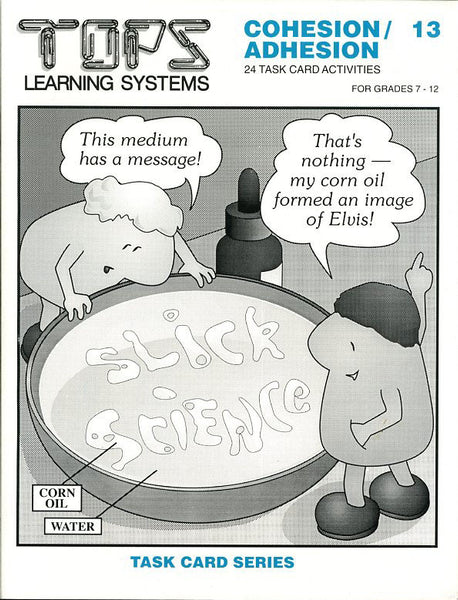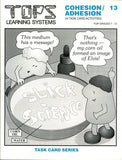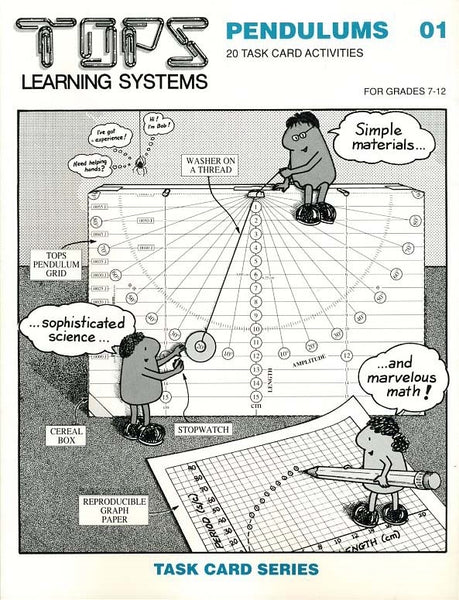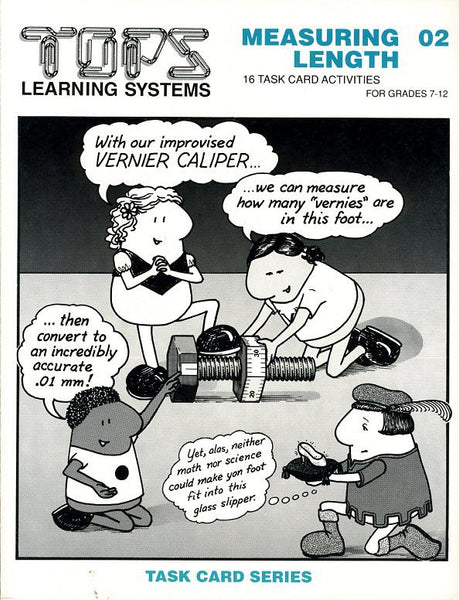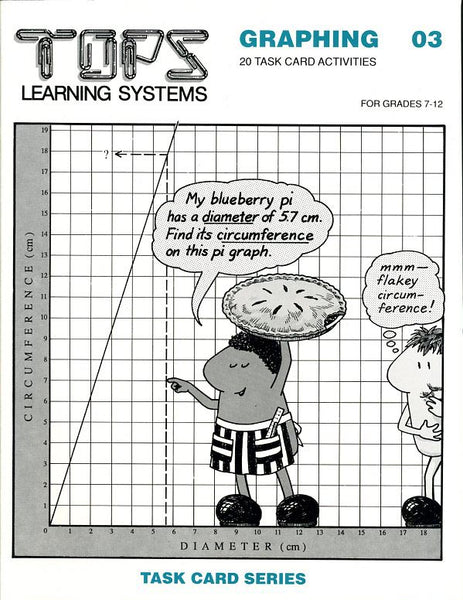#13 Cohesion/Adhesion (grades 6-10)
Regular price $20.95
Click here for a complete list of materials and convenient shopping.
dropper bottles with droppers, masking tape, blue food coloring, rubbing alcohol, tap water, liquid detergent, corn oil, waxed paper, graduated cylinders, 10mL, calculators, pennies, paper towels, scissors, large jars, wall clock, paper plates, drinking glasses, shallow bowls, fine pepper, straight pins (NOT steel), bar of soap, camphor, styrofoam cups, toothpicks, drinking straws, string, microscope slides, candles, paper clips, baby food jars, rubber bands, eyedroppers, hand lenses, newspaper, washable colored markers, clear tape, table salt, plastic tubs with lids, gallon milk jug, glycerin, distilled or deionized water (optional), thread, size-D batteries, dead or alive, corrugated cardboard, index cards, 4x6 inch, aluminum foil, medium test tubes (optional), meter sticks, vinegar (optional)- Lesson 1: To compare the size and shape of drops of different liquids. To order these liquids according to their relative cohesive strength.
- Lesson 2: To observe how cohesion holds water together on a penny. To recognize that soap weakens this cohesion.
- Lesson 3: To compare run times and trail patterns for various liquids that move down a wax paper ramp. To observe that different liquids adhere to wax paper with different strengths.
- Lesson 4: To observe the interactions of tap water, rubbing alcohol and soapy water with corn oil and waxed paper surfaces. To explain these interactions in terms of adhesion and cohesion.
- Lesson 5: To model the structure of water. To understand its cohesiveness in terms of electrostatic attraction.
- Lesson 6: To observe how small particles on the surface of water move in response to breaking hydrogen bonds.
- Lesson 7: To recognize that water cohesion creates an unbroken skin-like surface strong enough to support a pin. To distinguish between this phenomenon and floating.
- Lesson 8: To explain interactions of water, styrofoam and string in terms of adhesion, cohesion and surface tension.
- Lesson 9: To observe how water moves between glass slides by capillary action. To understand how adhesion and cohesion drive this process.
- Lesson 10: To understand why capillary action increases as water is squeezed within narrower space between glass.
- Lesson 11: To observe and explain surface interactions between glass and water in terms of cohesion, adhesion, surface tension and capillary action.
- Lesson 12: To study capillary action in a paper towel. To relate this process to the transpiration of water through trees.
- Lesson 13: To separate ink spots into their component colors using chromatography.
- Lesson 14: To develop a color mixing chart based on color chromatograms. To model why some dye combinations separate by capillary action better than others.
- Lesson 15: To form an oil slick on water with a drop of corn oil, and disperse it with a drop of soapy water. To understand the molecular forces at play.
- Lesson 16: To form oil films on water that reflect color by light interference. To understand this phenomenon as a function of film thickness.
- Lesson 17: To associate reduced surface tension in water with the formation of long-lasting surface bubbles. To admire the varied color patterns that result when light reflect off the surface of a thin bubble film.
- Lesson 18: To graph how wave trains interfere constructively when they are in phase, and destructively as they shift out of phase.
- Lesson 19: To model how thin oil films and thin soap films interfere with white light to produce a spectrum of color.
- Lesson 20: To observe bands of color reflected in soap film. To interpret this phenomenon in terms of light interference and variable film thickess.
- Lesson 21: To observe how cohesive forces in soap film contract it into a shape that minimizes total surface area.
- Lesson 22: To recognize that cohesive forces always contract soap film into shapes that minimize surface area, in both two and three dimensions.
- Lesson 23: To further explore the geometry of soap films.
- Lesson 24: To explore variables that influence bubble size.
ABOUT CAMPHOR: Toss the tiniest specks of dry camphor (the smaller the better), onto the surface skin of a glass of water (activity 6, step 4). Watch them zip and spin around, fueled by the energy of breaking hydrogen bonds! Don't allow water to adhere to the surface of these specks. If they get wet, adhesive water will surround and immobilize them. Camphor specks need to skate on the water to move freely, not swim in it.
ABOUT AMMONIA: "I am the one who called this past winter and asked if using colored/scented ammonia would be OK with TOPS Analysis because I couldn't get any plain ammonia here in Italy. Ron told me to go ahead and use the colored (yellow) and scented (lemon) ammonia and to tell him what happened.
The conclusion of all our experiments with yellow lemon-scented ammonia was that it was much weaker than normal, plain ammonia. When titrating with vinegar, for example, it took only 1 drop of vinegar to neutralize 1 drop of the colored, scented ammonia! Instead of almost 2:1, the ratio was 1:1. So, our numbers were all off, compared to the teacher's notes, but we were able to do all the experiments and the boys learned a great deal! (And I was reminded of all that I had buried somewhere in my brain!)"
From M.C. in Italy
TEACHING Standards
These 24 Task Cards promote excellence in science teaching by these NSES criteria:Teachers of science...
A: ...plan an inquiry-based science program. (p. 30)
B: ...guide and facilitate learning. (p. 32)
C: ...engage in ongoing assessment of their teaching and of student learning. (p. 37)
D: ...design and manage learning environments that provide students with the time, space, and resources needed for learning science. (p. 43)
CONTENT Standards
These 24 Task Cards contain fundamental content as defined by these NSES guidelines (p. 109).• Represent a central event or phenomenon in the natural world.
• Represent a central scientific idea and organizing principle.
• Have rich explanatory power.
• Guide fruitful investigations.
• Apply to situations and contexts common to everyday experiences.
• Can be linked to meaningful learning experiences.
• Are developmentally appropriate for students at the grade level specified.
Unifying Concepts and Processes
NSES Framework: Systems, order, and organization • Evidence, models and explanation • Constancy, change, and measurement • Evolution and equilibrium • Form and functionCore Concepts/Processes: Model hydrogen bonding - how water holds itself together. • Bubbles form shapes that minimize surface tension.
Science as Inquiry (content standard A)
NSES Framework: Identify questions that can be answered through scientific investigations. • Design and conduct a scientific investigation. • Use appropriate tools and techniques to gather, analyze, and interpret data. • Develop descriptions, explanations, predictions, and models using evidence. • Think critically and logically to connect evidence and explanations. • Recognize and analyze alternative explanations and predictions. • Communicate scientific procedures and explanations. • Use mathematics in all aspects of scientific inquiry.Core Inquiries: Why do some liquids heap, roll, creep and soak in, and others do not? • Account for color patterns on the surface of an oil slick and a bubble.
Physical Science (content standard B)
NSES Framework:Properties and changes of properties in matter • Motions and forces • Interactions of energy and matterCore Content:Cohesion • Adhesion • Surface tension • Hydrogen bonds • Ink-spot chromatography • Oil slicks • Light interference • Bubble geometry
Science in Personal and Social Perspectives (content standard F)
NSES Framework: Environmental qualityCore Content: Investigate the surface chemistry of oil spills.

